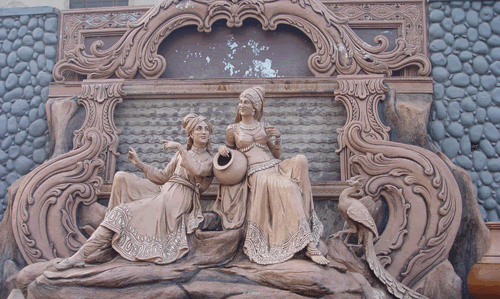|
Mathura:
Piety wafts through the streets

Photograph
by Preeti Verma Lal
Early morning in Mathura is a fascinating
study in colours - there's the khaki of the policemen who guard the Shri Krishna
Janambhoomi, the white of the milk simmering in huge black woks, the golden tan
of the stuffed kachoris, the orange of the sanyasis and the light brown of the
dust that rise like clouds from the sweeper's broom. It is neither very crowded
nor very raucous; a certain kind of piety wafts through the streets.
Early
morning in Mathura is a fascinating study in colours - there's the khaki of the
policemen who guard the Shri Krishna Janambhoomi, the white of the milk simmering
in huge black woks, the golden tan of the stuffed kachoris, the orange of the
sanyasis and the light brown of the dust that rise like clouds from the sweeper's
broom. It is neither very crowded nor very raucous; a certain kind of piety wafts
through the streets. And it is piety that brings thousands of people to this town
that once stood at the crossroads of several trade routes - eastwards towards
China, north through Taxila, Pushkalavati and Purushapur to Central Asia and the
Silk Route, and westwards to West Asia and the Roman Empire. Mathura
might have been mercantile but its renown borrows from a red sandstone platform
on which, according to mythology, Lord Krishna was born. Mathura is the Shri Krishna
Janambhoomi and the platform stands where it was 5,000 years ago. On it are several
framed photographs of Lord Krishna and His footprints are still visible.
The
temple doors open early but security is really tight. Innumerable policemen guard
the entrance and cameras and mobile phones are strictly prohibited. You are also
frisked before you can walk up the stairs that lead to the sanctum sanctorum.
The complex has several other temples and you learn about Hindu mythology through
tableaux that are open to public in the mornings and evenings. The
four lofty minarets of the Jama Masjid built in 1661 by Nabir Khan stand next
to the Janambhoomi and look resplendent in the morning sunlight. As
morning graduates towards noon, the crowd milling around the Janambhoomi get bigger.
The shops have upped their shutters and men, women and children of varied hues
are clamouring outside sweetmeat shops, buying stuffed kachoris, jalebis and downing
them with really frothy lassi. I head towards the Yamuna
that is dotted with picturesque ghats, of which Vishram Ghat is the most famous.
Legend has it that this is where Lord Krishna rested after having killed Kansa,
the tyrant king. Sitting almost next to the Yamuna is the Dwarikadheesh Temple,
a private temple built in 1814. The temple dedicated to Lord Dwarka is at its
glorious best during the Holi, Janamashtami and Diwali festivals. Even on an ordinary
day, women from all walks of life congregate in the temple courtyard invoking
Lord Dwarka for prosperity and health. A typical
Brajmandla Parikrama that includes pilgrimage to all the important temples and
the 12 main forests in Braja starts with a ritual bath at Vishram Ghat in Mathura.
The devotees then go clockwise, first heading southwest of Mathura and then north
to the seven main forests on the western flank of Yamuna. The parikrama then goes
south until it touches Baldeo (Dauji) and again moves north to Mahavan. The devotees
then return to Mathura concluding their parikrama with another bath at Vishram
Ghat. Some devotees bathe in all the 25 tirthas (bathing ghats) at the beginning
and end of the parikrama.
If archaeology
fascinates you, don't miss the Archaeological Museum at Dampier Park. Founded
by F. S. Growse, the then collector of Mathura, in 1874, the Museum has some rare
artifacts from the Gupta and the Kushan period (400 BC - 1200 AD). It houses the
most important collection of the Mathura School of Sculptures, dating back to
300 BC.
Yes, Mathura is about piety,
but it is also about pedas, those uneven balls of milk, sugar and dry fruits that
are famous worldwide. Bang opposite the Janambhoomi is Brajwasi Pedawalla, perhaps
the most famous in Mathura. The family has been making pedas for several decades
now. The recipe is never divulged but when I want to know what makes this peda
so different, the basic ingredients are shared with me - buffalo milk that is
simmered in huge woks for at least six hours and then mixed with sugar, cardamom
powder, dry fruits and the dough finally rolled into uneven balls.
At
night, the dust in Mathura settles, the woks are stacked, the shutters are downed
and the colours get blurred. All that stays awake is Faith and the lore of Lord
Krishna.
Published
in Discover India magazine, February 2005. Contact:
Preeti@deepblueink.com 
| 
